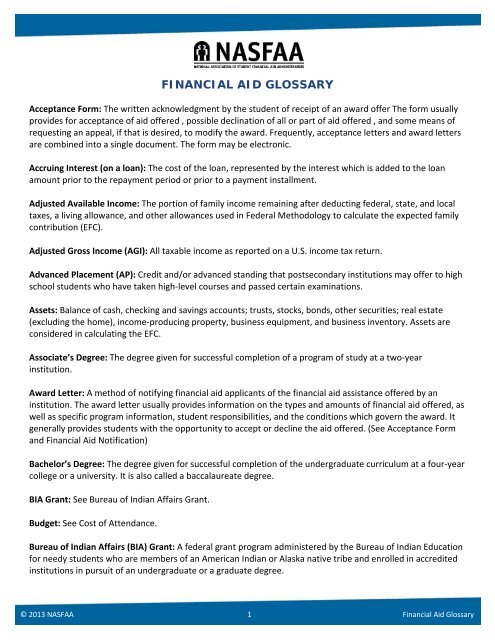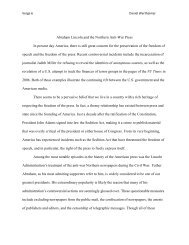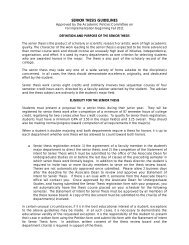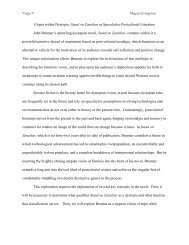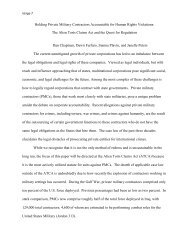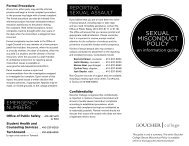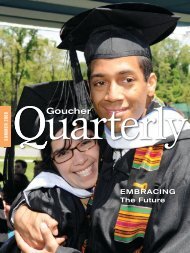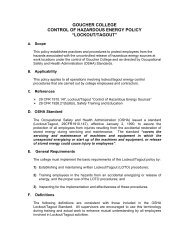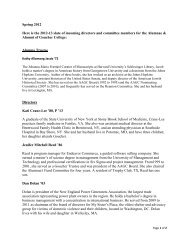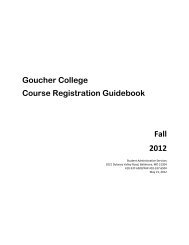NASFAA Financial Aid Glossary - National Association of Student ...
NASFAA Financial Aid Glossary - National Association of Student ...
NASFAA Financial Aid Glossary - National Association of Student ...
Create successful ePaper yourself
Turn your PDF publications into a flip-book with our unique Google optimized e-Paper software.
FINANCIAL AID GLOSSARY<br />
Acceptance Form: The written acknowledgment by the student <strong>of</strong> receipt <strong>of</strong> an award <strong>of</strong>fer The form usually<br />
provides for acceptance <strong>of</strong> aid <strong>of</strong>fered , possible declination <strong>of</strong> all or part <strong>of</strong> aid <strong>of</strong>fered , and some means <strong>of</strong><br />
requesting an appeal, if that is desired, to modify the award. Frequently, acceptance letters and award letters<br />
are combined into a single document. The form may be electronic.<br />
Accruing Interest (on a loan): The cost <strong>of</strong> the loan, represented by the interest which is added to the loan<br />
amount prior to the repayment period or prior to a payment installment.<br />
Adjusted Available Income: The portion <strong>of</strong> family income remaining after deducting federal, state, and local<br />
taxes, a living allowance, and other allowances used in Federal Methodology to calculate the expected family<br />
contribution (EFC).<br />
Adjusted Gross Income (AGI): All taxable income as reported on a U.S. income tax return.<br />
Advanced Placement (AP): Credit and/or advanced standing that postsecondary institutions may <strong>of</strong>fer to high<br />
school students who have taken high-level courses and passed certain examinations.<br />
Assets: Balance <strong>of</strong> cash, checking and savings accounts; trusts, stocks, bonds, other securities; real estate<br />
(excluding the home), income-producing property, business equipment, and business inventory. Assets are<br />
considered in calculating the EFC.<br />
Associate’s Degree: The degree given for successful completion <strong>of</strong> a program <strong>of</strong> study at a two-year<br />
institution.<br />
Award Letter: A method <strong>of</strong> notifying financial aid applicants <strong>of</strong> the financial aid assistance <strong>of</strong>fered by an<br />
institution. The award letter usually provides information on the types and amounts <strong>of</strong> financial aid <strong>of</strong>fered, as<br />
well as specific program information, student responsibilities, and the conditions which govern the award. It<br />
generally provides students with the opportunity to accept or decline the aid <strong>of</strong>fered. (See Acceptance Form<br />
and <strong>Financial</strong> <strong>Aid</strong> Notification)<br />
Bachelor’s Degree: The degree given for successful completion <strong>of</strong> the undergraduate curriculum at a four-year<br />
college or a university. It is also called a baccalaureate degree.<br />
BIA Grant: See Bureau <strong>of</strong> Indian Affairs Grant.<br />
Budget: See Cost <strong>of</strong> Attendance.<br />
Bureau <strong>of</strong> Indian Affairs (BIA) Grant: A federal grant program administered by the Bureau <strong>of</strong> Indian Education<br />
for needy students who are members <strong>of</strong> an American Indian or Alaska native tribe and enrolled in accredited<br />
institutions in pursuit <strong>of</strong> an undergraduate or a graduate degree.<br />
© 2013 <strong>NASFAA</strong> 1 <strong>Financial</strong> <strong>Aid</strong> <strong>Glossary</strong>
Business Assets: Property that is used in the operation <strong>of</strong> a trade or business, including real estate,<br />
inventories, buildings, machinery and other equipment, patents, franchise rights, and copyrights. Business<br />
assets are considered in the calculation <strong>of</strong> the EFC under the regular formula.<br />
Campus-Based Programs: The term commonly applied to federal student aid programs administered directly<br />
by participating postsecondary institutions. Campus-based programs include: Federal Perkins Loan, Federal<br />
Supplemental Educational Opportunity Grant (FSEOG), and Federal Work-Study (FWS).<br />
Capitalization (<strong>of</strong> interest): The arrangement between borrower and lender whereby interest payments are<br />
deferred as they come due and are added to the principal amount <strong>of</strong> the loan.<br />
Central Processing System (CPS): The computer system to which the student’s need analysis data is<br />
electronically transmitted by the Free Application for Federal <strong>Student</strong> <strong>Aid</strong> (FAFSA) processor. The Central<br />
Processing System performs database matches, calculates the student’s <strong>of</strong>ficial EFC, and generates the<br />
<strong>Student</strong> <strong>Aid</strong> Report (SAR).<br />
Certificate: The formal acknowledgment <strong>of</strong> successful completion <strong>of</strong> a particular program or course <strong>of</strong> study,<br />
particularly at a community college or career college.<br />
CLEP: See College-Level Examination Program.<br />
COA: See Cost <strong>of</strong> Attendance.<br />
College-Level Examination Program (CLEP): A series <strong>of</strong> examinations demonstrating a student’s pr<strong>of</strong>iciency in<br />
a subject area, for which some postsecondary institutions <strong>of</strong>fer credit.<br />
Commuter <strong>Student</strong>: A student who does not live on campus; typically, “commuter” refers to a student living<br />
at home with his or her parents, but can also mean any student who lives <strong>of</strong>f campus.<br />
Consolidation Loan: A loan made to enable a borrower with different types <strong>of</strong> loans or multiple loans to<br />
obtain a single loan with one interest rate and one repayment schedule. Federal Perkins Loans, Direct<br />
Subsidized and Direct Unsubsidized Loans, Health Education Assistance Loans (HEAL), Health Pr<strong>of</strong>essions<br />
<strong>Student</strong> Loans (HPSL), and Loans for Disadvantaged <strong>Student</strong>s may be combined for purposes <strong>of</strong> consolidation,<br />
subject to certain eligibility requirements. A consolidation loan pays <strong>of</strong>f the existing loans; the borrower then<br />
repays the consolidated loan.<br />
Cooperative Education: A program through which a college student alternates periods <strong>of</strong> classroom<br />
instruction with periods <strong>of</strong> related employment.<br />
Cost <strong>of</strong> Attendance (COA): Generally, this includes the tuition and fees normally assessed a student, together<br />
with the institution’s estimate <strong>of</strong> the cost <strong>of</strong> room and board, transportation and commuting costs, books and<br />
supplies, the cost <strong>of</strong> a computer, and miscellaneous personal expenses. In addition, student loan fees,<br />
dependent care, reasonable costs for a study abroad or cooperative education program, and/or costs related<br />
to a disability may be included, when appropriate. It is also referred to as “cost <strong>of</strong> education” or “budget.”<br />
CPS: See Central Processing System.<br />
<strong>Financial</strong> <strong>Aid</strong> <strong>Glossary</strong> 2 © 2013 <strong>NASFAA</strong>
Credit (or Credit Hour): The unit <strong>of</strong> measurement some institutions give for fulfilling course requirements.<br />
Custodial Parent: The parent with whom a dependent student lives, and whose financial information is used in<br />
need analysis when parents are divorced or separated.<br />
Data Release Number: A four-digit number assigned to a student’s FAFSA that allows the student to release<br />
the FAFSA information to postsecondary institutions that were not originally listed on the FAFSA.<br />
Deferment (<strong>of</strong> loan): A condition during which payments <strong>of</strong> the principal balance are not required, and for<br />
Federal Perkins Loans and Direct Subsidized Loans, interest does not accrue. The repayment period is<br />
extended by the length <strong>of</strong> the deferment period.<br />
Department <strong>of</strong> Education, U.S. (ED): The federal government agency that administers assistance to students<br />
enrolled in postsecondary educational programs under the following programs: Federal Pell Grant, Iraq and<br />
Afghanistan Service Grant (IASG); Teacher Education Assistance for College and Higher Education (TEACH)<br />
Grant, Federal Perkins Loan, Federal Supplemental Educational Opportunity Grant (FSEOG), Federal Work-<br />
Study (FWS), and William D. Ford Federal Direct Loan (Direct Loan) Program.<br />
Departmental Scholarship: An award <strong>of</strong> gift assistance that is specifically designated for a recipient in a<br />
particular academic department within the institution.<br />
Dependent <strong>Student</strong>: A student who does not qualify as an independent student and whose parental income<br />
and asset information is used in calculating the EFC (see Independent <strong>Student</strong>).<br />
Direct PLUS Loan: Long-term loans made available to parents <strong>of</strong> dependent students and<br />
graduate/pr<strong>of</strong>essional students. Interest rates are fixed at 7.9 %. May be used to replace EFC; amount<br />
borrowed is limited to the cost <strong>of</strong> attendance minus estimated financial assistance.<br />
Direct Subsidized and Direct Unsubsidized Loans: Long-term, low-interest loans administered by the<br />
Department <strong>of</strong> Education and institutions. Loans carry a fixed interest rate. Direct Unsubsidized Loans can be<br />
used to replace EFC.<br />
Educational Benefits: Funds, primarily federal, awarded to certain categories <strong>of</strong> students (veterans, children <strong>of</strong><br />
deceased veterans or other deceased wage earners, and students with physical disabilities) to help finance<br />
their postsecondary education regardless <strong>of</strong> their ability to demonstrate need in the traditional sense.<br />
Educational Expenses: See Budget and Cost <strong>of</strong> Attendance.<br />
EFC: See Expected Family Contribution.<br />
Employment: With reference to financial aid, the opportunity for students to earn money to help pay for their<br />
education. Federal Work-Study is one program by which needy students can work to help pay their<br />
educational expenses.<br />
© 2013 <strong>NASFAA</strong> 3 <strong>Financial</strong> <strong>Aid</strong> <strong>Glossary</strong>
Employment Allowance: An allowance to meet expenses related to employment when both parents (or a<br />
married independent student and spouse) are employed or when one parent (or independent student)<br />
qualifies as a surviving spouse or as head <strong>of</strong> a household. It is used in the need analysis formula for parents<br />
and student, if eligible.<br />
Estimated <strong>Financial</strong> Assistance (EFA): The total assistance that a student is receiving to <strong>of</strong>fset the cost <strong>of</strong> a<br />
postsecondary education, including scholarships, Title IV aid, need-based work assistance, and private loans,<br />
that is subtracted from a student’s need when determining eligibility for campus-based aid, Direct Subsidized<br />
and Unsubsidized Loans, and PLUS.<br />
Expected Family Contribution (EFC): The amount a student and his or her family is expected to contribute<br />
toward the student’s cost <strong>of</strong> attendance as calculated by a Congressionally-mandated formula known as<br />
Federal Methodology. The EFC is used to determine a student’s eligibility for the student financial assistance<br />
programs.<br />
FAFSA: See Free Application for Federal <strong>Student</strong> <strong>Aid</strong>.<br />
FAFSA4Caster: Allows students and families to input financial information and receive an estimate <strong>of</strong> their<br />
federal aid eligibility before filing the FAFSA.<br />
FAFSA on the Web (FOTW): Allows students to complete and file a FAFSA online at www.fafsa.gov.<br />
Federal Direct <strong>Student</strong> Loan (Direct Loan) Program: The collective name for the Direct Subsidized, Direct<br />
Unsubsidized, Direct PLUS, and Direct Consolidation Loan Programs. Loan funds for these programs are<br />
provided by the federal government to students and parents through postsecondary institutions.<br />
Federal Methodology (FM): A standardized method for determining a student’s (and family’s) ability to pay<br />
for postsecondary education expenses. The single formula for determining an EFC for Federal Pell Grants,<br />
campus-based programs, and Direct Loan programs; the formula is defined by law.<br />
Federal Pell Grant: A federal grant program for needy postsecondary students who have not yet received a<br />
baccalaureate or first pr<strong>of</strong>essional degree; administered by the U.S. Department <strong>of</strong> Education.<br />
Federal Perkins Loan: One <strong>of</strong> the campus-based programs; a long-term, low-interest loan program for both<br />
undergraduate and graduate students at a current interest rate <strong>of</strong> 5%. At one time it was known as the Carl D.<br />
Perkins <strong>National</strong> Direct <strong>Student</strong> Loan Program (NDSL).<br />
Federal Supplemental Educational Opportunity Grant (FSEOG): One <strong>of</strong> the campus-based programs; grants to<br />
undergraduate students <strong>of</strong> exceptional financial need who have not completed their first baccalaureate<br />
degree and who are financially in need <strong>of</strong> this grant to enable them to pursue their education. Priority for<br />
FSEOG awards must be given to Federal Pell Grant recipients with the lowest EFCs.<br />
Federal Work-Study (FWS) Program: One <strong>of</strong> the campus-based programs; a part-time employment program<br />
which provides jobs for undergraduate and graduate students who are in need <strong>of</strong> earnings to meet a portion<br />
<strong>of</strong> their educational expenses.<br />
<strong>Financial</strong> <strong>Aid</strong> <strong>Glossary</strong> 4 © 2013 <strong>NASFAA</strong>
<strong>Financial</strong> <strong>Aid</strong>: General term that describes any source <strong>of</strong> student assistance outside <strong>of</strong> the student or the<br />
student’s family. Funds awarded to a student to help meet postsecondary educational expenses. These funds<br />
are generally awarded on the basis <strong>of</strong> financial need and include loans, grants and/or scholarships, and/or<br />
student employment.<br />
<strong>Financial</strong> <strong>Aid</strong> Administrator: An individual who is responsible for preparing and communicating information<br />
pertaining to student loans, grants and/or scholarships, and/or student employment programs, and for<br />
advising, awarding, reporting, counseling, and supervising <strong>of</strong>fice functions related to student financial aid. A<br />
financial aid administrator is accountable to the various federal, state, and institutional entities that provide<br />
aid and interprets and implements federal, state, and institutional policies and regulations, and is capable <strong>of</strong><br />
analyzing student and employee needs and making changes where necessary.<br />
<strong>Financial</strong> <strong>Aid</strong> Award: An <strong>of</strong>fer <strong>of</strong> financial or in-kind assistance to a student attending a postsecondary<br />
educational institution. This award may be in the form <strong>of</strong> one or more <strong>of</strong> the following types <strong>of</strong> financial aid:<br />
loans, grants and/or scholarships, and/or student employment.<br />
<strong>Financial</strong> <strong>Aid</strong> Consultant: A person who, for a fee, provides a variety <strong>of</strong> services to students and parents,<br />
including preparing the FAFSA and other financial aid forms, estimating the EFC, and estimating financial need.<br />
<strong>Financial</strong> <strong>Aid</strong> Notification: The letter from a postsecondary institution that notifies the student whether or not<br />
aid has been awarded. If the student will be receiving assistance, the notification also describes the financial<br />
aid package. State agencies and private organizations may send students financial aid notifications separately<br />
from the postsecondary institution. Also see Award Letter.<br />
<strong>Financial</strong> <strong>Aid</strong> Package: A financial aid award to a student that can be comprised <strong>of</strong> a combination <strong>of</strong> forms <strong>of</strong><br />
financial aid (loans, grants, scholarships, and student employment).<br />
<strong>Financial</strong> Need: The difference between the institution’s cost <strong>of</strong> attendance and the family’s ability to pay (i.e.,<br />
EFC). Ability to pay is represented by the EFC for federal need-based aid and for many state and institutional<br />
programs.<br />
<strong>Financial</strong> Need Equation: Cost <strong>of</strong> attendance minus expected family contribution equals financial need (COA -<br />
EFC = Need).<br />
FM: See Federal Methodology.<br />
Forbearance: Permits the temporary cessation <strong>of</strong> repayments <strong>of</strong> loans, allowing an extension <strong>of</strong> time for<br />
making loan payments, or accepting smaller loan payments than were previously scheduled.<br />
Free Application for Federal <strong>Student</strong> <strong>Aid</strong> (FAFSA): The financial aid application completed by the student, and<br />
the student’s parents if applicable, that collects household and financial information. The FAFSA is the<br />
foundation document for all federal need analysis computations and database matches performed for a<br />
student.<br />
FSEOG: See Federal Supplemental Educational Opportunity Grant.<br />
© 2013 <strong>NASFAA</strong> 5 <strong>Financial</strong> <strong>Aid</strong> <strong>Glossary</strong>
Gift <strong>Aid</strong>: Educational funds such as grants or scholarships that do not require repayment from present or<br />
future earnings. See Grant.<br />
Grace Period: The period <strong>of</strong> time that begins when a loan recipient ceases to be enrolled at least half time and<br />
ends when the repayment period starts. Loan principal need not be paid and, depending on the loan, interest<br />
does not accrue during this period.<br />
Grant: A type <strong>of</strong> financial aid that does not have to be repaid; usually awarded on the basis <strong>of</strong> need, possibly<br />
combined with some skills or characteristics the student possesses. Also see Gift <strong>Aid</strong>.<br />
Health and Human Services, U.S. Department <strong>of</strong> (HHS): The federal government agency that provides<br />
assistance to future health care practitioners. The Nursing <strong>Student</strong> Loan, Health Pr<strong>of</strong>ession <strong>Student</strong> Loan, and<br />
Scholarships for Disadvantaged <strong>Student</strong>s are among some <strong>of</strong> the aid programs administered by HHS.<br />
Health Pr<strong>of</strong>essions Programs: Federal student assistance programs administered by the U.S. Department <strong>of</strong><br />
Health and Human Services for students preparing for careers in the health sciences.<br />
HHS: See Health and Human Services, U.S. Department <strong>of</strong>.<br />
Income: Amount <strong>of</strong> money received from any or all <strong>of</strong> the following: wages, interest, dividends, sales or rental<br />
<strong>of</strong> property or services, business or farm pr<strong>of</strong>its, and subsistence allowances such as taxable Social Security<br />
benefits and child support.<br />
Income Protection Allowance (IPA): An allowance against income for the basic costs <strong>of</strong> maintaining family<br />
members in the home. The allowance is based upon consumption and other cost estimates <strong>of</strong> the U.S. Bureau<br />
<strong>of</strong> Labor Statistics for a family at the low standard <strong>of</strong> living.<br />
Independent <strong>Student</strong>: A student who:<br />
(a) Will be 24 years <strong>of</strong> age by December 31 <strong>of</strong> the award year;<br />
(b) Is an orphan or a ward <strong>of</strong> the court;<br />
(c) Is an orphan, in foster care, or a ward <strong>of</strong> the court, at any time when the student was 13 years <strong>of</strong> age or<br />
older;<br />
(d) Is an emancipated minor or is in legal guardianship as determined by a court in the student’s state <strong>of</strong> legal<br />
residence;<br />
(e) Is an unaccompanied youth who is homeless or who is at risk <strong>of</strong> homelessness and is self-supporting, as<br />
documented during the school year;<br />
(f) Is a veteran;<br />
(g) Is serving on active duty in the U.S. Armed Forces for purposes other than training;<br />
(h) Is married;<br />
(i) Is a graduate or pr<strong>of</strong>essional student;<br />
(j) Has legal dependents other than a spouse;<br />
(k)Has dependent children; or<br />
(l) Presents documentation <strong>of</strong> other unusual circumstances demonstrating independence to the financial aid<br />
administrator.<br />
<strong>Financial</strong> <strong>Aid</strong> <strong>Glossary</strong> 6 © 2013 <strong>NASFAA</strong>
Investment Plans: Coverdell Educational Savings Accounts and state 529 plans are examples <strong>of</strong> educational<br />
investment plans that can be used to assist with higher education expenses, usually sponsored by commercial<br />
banking institutions.<br />
Iraq and Afghanistan Service Grant (IASG): A non-need-based federal grant program for students whose<br />
parent or guardian died as the result <strong>of</strong> military service in Iraq or Afghanistan after September 11, 2001. If a<br />
student is eligible for a Federal Pell Grant, he or she cannot receive an IASG.<br />
Legal Dependent (<strong>of</strong> Applicant): A biological or adopted child, or a person for whom the applicant has been<br />
appointed legal guardian, and for whom the applicant provides more than half support. In addition, a legal<br />
dependent is a person who lives with and receives at least half support from the applicant and will continue to<br />
receive that support during the award year. For purposes <strong>of</strong> determining dependency status, a spouse is not<br />
considered a legal dependent.<br />
Loan: An advance <strong>of</strong> funds evidenced by a promissory note and requiring the recipient to repay the specified<br />
amount(s) under prescribed conditions.<br />
Loan Repayment Program: A special program available to qualified students who have attended college on<br />
federally-funded student loans and for whom loans are repaid based upon employment in a particular field or<br />
with a participating federal agency, including the Army, Navy, and Air Force.<br />
Master Promissory Note (MPN): A promissory note for the Federal Perkins Loan and Direct Loan programs<br />
that allows borrowers to apply for multiple loans during a student’s attendance at a postsecondary institution.<br />
Means-Tested Federal Benefit Program: A federal benefit program for which the applicant must demonstrate<br />
financial need.<br />
Merit-based <strong>Aid</strong>: <strong>Financial</strong> aid awarded because <strong>of</strong> a student’s achievement or talent in a particular area, such<br />
as academics, athletics, music, etc.<br />
Methodology: Refers to the system used to calculate the expected family contribution, see Federal<br />
Methodology.<br />
Military Scholarships: Reserve Officer Training Corps (ROTC) scholarships available for the Army, Navy, and Air<br />
Force at participating postsecondary institutions throughout the United States. These scholarships cover<br />
tuition and fees, books and supplies, and include a subsistence allowance.<br />
<strong>National</strong> Health Service Corps Scholarship (NHSC): Scholarship program for students who pursue full-time<br />
courses <strong>of</strong> study in certain health pr<strong>of</strong>essions disciplines, and are willing to serve as primary care practitioners<br />
in underserved areas after completing their education.<br />
<strong>National</strong> and Community Service: A program established through the <strong>National</strong> and Community Service Trust<br />
Act <strong>of</strong> 1993 designed to reward individuals who provide community service with educational benefits and/or<br />
loan forgiveness or cancellation.<br />
Need: See <strong>Financial</strong> Need.<br />
© 2013 <strong>NASFAA</strong> 7 <strong>Financial</strong> <strong>Aid</strong> <strong>Glossary</strong>
Need Analysis: A system by which an applicant’s ability to pay for educational expenses is evaluated and<br />
calculated. Need analysis consists <strong>of</strong> two primary components: (a) determination <strong>of</strong> an estimate <strong>of</strong> the<br />
applicant’s and/or family’s ability to contribute to educational expenses; and (b) determination <strong>of</strong> an accurate<br />
estimate <strong>of</strong> the educational expenses themselves.<br />
Need Analysis Formula: Defines the data elements used to calculate the EFC; there are two distinct formulas:<br />
regular and simplified. The formula determines the EFC under the Federal Methodology.<br />
Need-based <strong>Aid</strong>: <strong>Student</strong> assistance awarded because <strong>of</strong> a student’s demonstrated calculated need for<br />
assistance.<br />
Non-Need-based <strong>Aid</strong>: <strong>Student</strong> financial assistance based on criteria other than need, such as academic,<br />
musical, or athletic ability. Also, refers to federal student aid programs where the EFC is not part <strong>of</strong> the need<br />
equation.<br />
Packaging: The process <strong>of</strong> combining various types <strong>of</strong> student aid (loans, grants, scholarships, and student<br />
employment) to attempt to meet the full amount <strong>of</strong> a student’s need.<br />
Parent Contribution: A quantitative estimate <strong>of</strong> the parents’ ability to contribute to the postsecondary<br />
educational expenses <strong>of</strong> a dependent student.<br />
PDF FAFSA: A version <strong>of</strong> the FAFSA viewed using Adobe Acrobat which may be completed and filed like a<br />
paper FAFSA.<br />
PLUS: See Direct PLUS Loan.<br />
Principal (<strong>of</strong> a loan): The amount <strong>of</strong> money borrowed through a loan; does not include interest or other<br />
charges, unless they are capitalized.<br />
Pr<strong>of</strong>essional Judgment (PJ): The financial aid administrator’s discretion, based on the special circumstances <strong>of</strong><br />
the student, to change the data elements used in determining eligibility for federal student aid or adjust a<br />
student’s cost <strong>of</strong> attendance.<br />
Promissory Note: The legal document which binds a borrower to the repayment obligations and other terms<br />
and conditions which govern a loan program.<br />
Repayment Schedule: A plan that is provided to the borrower at the time he or she ceases at least half-time<br />
enrollment. The plan sets forth the principal and interest due on each installment and the number <strong>of</strong><br />
payments required to pay the loan in full. Additionally, it includes the interest rate, the due date <strong>of</strong> the first<br />
payment, and the frequency <strong>of</strong> payments.<br />
Reserve Officers Training Corps Scholarship Program: See ROTC Scholarship Program.<br />
ROTC Scholarship Program: Competitive scholarship that pays for tuition, fees, books, and a monthly living<br />
stipend and other benefits in exchange for participating in drills and classes during the academic year, military<br />
camp during the summer, and, upon graduation, full-time active duty in the military for at least four years.<br />
<strong>Financial</strong> <strong>Aid</strong> <strong>Glossary</strong> 8 © 2013 <strong>NASFAA</strong>
SAR: See <strong>Student</strong> <strong>Aid</strong> Report.<br />
SAR Acknowledgment: A noncorrectable, one-page <strong>Student</strong> <strong>Aid</strong> Report. <strong>Student</strong>s who file a FAFSA on the Web<br />
(FOTW) or submit online corrections without providing a valid email address receive this output document.<br />
Scholarship: A form <strong>of</strong> financial assistance that does not require repayment or employment and is usually<br />
made to students who demonstrate or show potential for distinction, usually in academic performance.<br />
Scholarship Search Services: Organizations that may help students find little known and unused financial aid<br />
funds. Families who are interested in using such a service should carefully investigate the company first.<br />
Service Academy: The five postsecondary institutions administered by branches <strong>of</strong> the military [U.S. Military<br />
Academy, U.S. Air Force Academy, U.S. Naval Academy, U.S. Coast Guard Academy, and U.S. Merchant Marine<br />
Academy].<br />
Simplified Needs Test (SNT): An alternate method <strong>of</strong> calculating the EFC for families with incomes <strong>of</strong> less than<br />
$50,000, and who meet one <strong>of</strong> the following conditions: filed, or are eligible to file, an IRS Form 1040A or<br />
1040EZ, are not required to file an income tax return, who have a household member who received benefits<br />
through a federal means-tested benefit program, or is a dislocated worker. The SNT excludes all assets from<br />
consideration in the calculation <strong>of</strong> the EFC.<br />
<strong>Student</strong> <strong>Aid</strong> Report (SAR): The <strong>of</strong>ficial notification sent to a student as a result <strong>of</strong> the CPS receiving an<br />
applicant record (FAFSA) for a student. The SAR summarizes applicant information, provides the EFC for a<br />
student, and displays other special messages related to the student’s application. In some instances the SAR<br />
may need to be submitted to the financial aid <strong>of</strong>fice at the school the student plans to attend, but only if the<br />
school requests it. Depending on how the student submits the FAFSA, the SAR is either a paper or electronic<br />
document.<br />
<strong>Student</strong> Contribution: A quantitative estimate <strong>of</strong> the student’s ability to contribute to postsecondary<br />
expenses for a given year.<br />
Subsidy: The money the federal government uses to help underwrite student aid programs.<br />
Taxable Income: Income earned from wages, salaries, and tips, as well as interest income, dividend income,<br />
business or farm pr<strong>of</strong>its, and rental or property income.<br />
Teacher Education Assistance for College and Higher Education (TEACH) Grants: A federal non-need-based<br />
grant awarded to undergraduate and graduate students who want to pursue a teaching career in a high-need<br />
field and who agree to teach in a school serving low-income students (Title I schools) after graduating. If a<br />
recipient does not fulfill the service requirement, funds convert into a Direct Unsubsidized Loan.<br />
Title IV Programs: Those federal student aid programs authorized under Title IV <strong>of</strong> the Higher Education Act <strong>of</strong><br />
1965, as amended. Includes the: Federal Pell Grant, Iraq and Afghanistan Service Grant (IASG), Teacher<br />
Education Assistance for College and Higher Education (TEACH) Grant, Federal Supplemental Educational<br />
Opportunity Grant, Federal Work-Study, Federal Perkins Loan, Direct Loan, and Direct PLUS.<br />
© 2013 <strong>NASFAA</strong> 9 <strong>Financial</strong> <strong>Aid</strong> <strong>Glossary</strong>
Tuition Payment Plans: A strategy by which payment for present costs <strong>of</strong> postsecondary education is<br />
extended into a future period <strong>of</strong> time.<br />
Unmet Need: The difference between a student’s total cost <strong>of</strong> attendance at a specific institution and the<br />
student’s total available resources.<br />
Untaxed Income: All income received that is not reported to the Internal Revenue Service (IRS) or is reported<br />
but excluded from taxation. Such income would include but not be limited to untaxed capital gains, interest on<br />
tax-free bonds, dividend exclusion, and military and other subsistence and living allowances.<br />
Verification: A process used to confirm data reported on the FAFSA. Institutions are authorized to obtain<br />
documentation to confirm the information reported on the FAFSA.<br />
Veterans Educational Benefits: Assistance programs for eligible veterans and/or their dependents for<br />
education or training.<br />
Vocational Rehabilitation: Programs administered by state departments <strong>of</strong> vocational rehabilitation services<br />
to assist individuals who have a physical or mental disability which is a substantial handicap to employment.<br />
<strong>Financial</strong> <strong>Aid</strong> <strong>Glossary</strong> 10 © 2013 <strong>NASFAA</strong>
ABBREVIATIONS COMMONLY USED IN FINANCIAL AID ADMINISTRATION<br />
ACT: American College Testing Program<br />
AGI: Adjusted Gross Income<br />
BA or BS: Baccalaureate Degree<br />
BIA: Bureau <strong>of</strong> Indian Affairs<br />
CLEP: College-Level Examination Program<br />
COA: Cost <strong>of</strong> Attendance<br />
CPS: Central Processing System<br />
ED: Department <strong>of</strong> Education<br />
EFC: Expected Family Contribution (also FC, Family Contribution)<br />
FAFSA: Free Application for Federal <strong>Student</strong> <strong>Aid</strong><br />
FM: Federal Methodology<br />
FOTW: FAFSA on the Web<br />
FSEOG: Federal Supplemental Educational Opportunity Grant<br />
FWS: Federal Work-Study<br />
GPA: Grade Point Average<br />
HHS: Department <strong>of</strong> Health and Human Services<br />
IPA: Income Protection Allowance<br />
IRS: Internal Revenue Service<br />
PC: Parental Contribution<br />
ROTC: Reserve Officer Training Corps<br />
SAR: <strong>Student</strong> <strong>Aid</strong> Report<br />
SAT: Scholastic Aptitude Test<br />
SC: <strong>Student</strong> Contribution<br />
© 2013 <strong>NASFAA</strong> 11 <strong>Financial</strong> <strong>Aid</strong> <strong>Glossary</strong>


